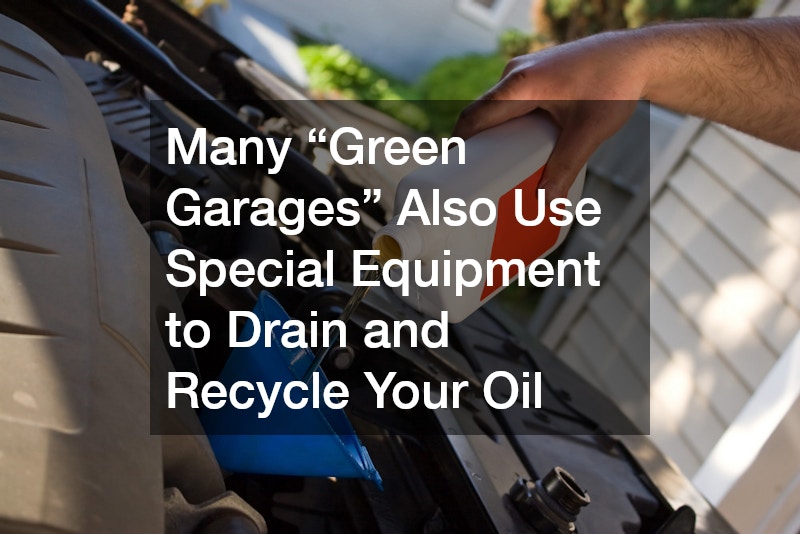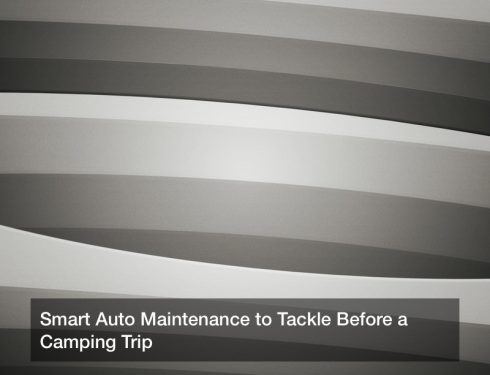
When you own a car, you know it will eventually need repairs. According to Car Sauce, one of the best ways to reduce the frequency of car repairs will be to maintain your car’s regular maintenance schedule. One of the most essential components of your car’s maintenance is oil change; at least every 3000 miles.
Many car owners may decide to get a quick lube and oil at a place that specializes in oil changes. However, if you have an auto repair facility you trust, you might find that they offer an oil change subscription for regular customers. You may wonder, “Does a car run better after an oil change?” According to Auto Passionate, it will improve your car’s performance by lubricating and cooling the components of your engines.
If you want to do your part to participate in eco-friendly practices, you should opt for a “green oil change.” According to Auto Oil and Fluids, the first choice you should make is to switch to a plant-based synthetic oil. These eco-friendly oils have the same lubricating effects while decreasing your emissions. Many “green garages” also use special equipment to drain and recycle your oil. 
The United States is, without any doubt, a nation of cars. On average, Americans are known to drive in their passenger trucks and cars for about 10,000 miles per year, and some people drive much more than that. If a person is not driving to work or college, then they are probably driving for leisure, and this includes camping trips. A camping trip is a wonderful opportunity to get back into nature and relax, and it can be much more affordable and convenient than flying to another state or touring the globe. Camping can vary widely, from taking an SUV to the woods with a tent, all the way to a huge RV, such as a sizeable motor home or fifth-wheel trailer. But going camping means driving, and before a camping trip can start, a car owner should make sure that their vehicle is ready for the road. Some Americans can drive for hours before arriving at a campsite for their weekend camping trip, after all. That car or truck must be ready for the journey.

This probably won’t apply to many campers, but in some cases, it is vital for a camping enthusiast to visit an auto dealer and find a new vehicle for all of their future planned camping trips. For example, suppose the camper just bought a new RV that their current truck lacks the strength to tow? Anyone who is dedicated to camping may choose to trade in their current truck fora new one to expand their RV towing options, so this should factor into their search for used cars and trucks. To begin the search, the customer can browse the online catalogs that nearby auto dealers offer, and narrow down their options based on a vehicle’s age, mileage, horsepower, features, and any other desired factors.
Visiting the dealer comes next, where the customer can check out promising cars or trucks in person and take them for a test drive. Don’t forget that auto dealers are usually connected to five to 10 different money lending services, such as banks, so auto loans can be made. It is quite typical for buyers to finance a vehicle, even if they are buying used. Once the buyer gets their hands on a truck or SUV capable of towing their RV or pop-up camper, they can look into further auto repair and tuning before hitting the road. It is best to check off as many boxes as possible before a long-distance camping trip.

No matter where a motorist is going, safety must come first, and this factors in both the car’s performance and the driver’s own condition. It should be noted that around three million auto accidents take place across the United States per year, many of which result in one or more injuries among involved parties. Someone who gets badly hurt in an accident will probably turn to an auto accident injury attorney, and they can form a case in litigation against the at-fault party. Not all cases actually go to court (this is a costly and time-consuming process), but overall, better safe than sorry, as they say.
How can a camper stay safe en route to their campsite? For one thing, they should drive defensively; that is, avoid any reckless or aggressive driving tactics, and avoid drivers who do behave that way. A driver should also keep the weather in mind, and drive more slowly and carefully in certain conditions. During heavy rain, snow, or fog, visibility is much lower, and that necessitates careful driving. The same is true if snow or ice is making the road slick, and after rain, hydroplaning is a real hazard on the roads. And if that driver is towing a heavy RV, they should be extra careful.
A driver must also make sure that their coordination, attention span, and reflexes are not being hampered. Absolutely no drinking and driving should happen, and drivers should avoid drugs, too. But those are not the only hazards; a very tired driver can be nearly as dangerous as a drunk one since an exhausted person also has slow reflexes, coordination, and judgment. A very tired driver should allow someone else in their party to drive, or else take a nap somewhere safe or simply wait for a better time of day to drive. It may not be a good idea to think “just one more hour” while driving very tired. Many drivers really do fall asleep at the wheel across the nation, with predictable results.

This is definitely one of the biggest areas of concern: auto repair. A car, especially a used one or one that is on the road often, will need some inspections and maintenance before it’s used for a long trip. Cars can break down in unexpected ways at unexpected times, and before the big camping trip, the driver should make sure their vehicle can make it all the way there (and back). A week or two before the camping trip, the driver ought to take their vehicle to a reliable auto shop for thorough inspections, both inside and out, from checking out its automotive hose clamps to its oil filter and the state of its ball bearings. Anything that needs repair or replacement can get it, and don’t forget the tires, either.
No part of the car should be taken for granted, least of all the tires. A car’s tires may allow it to either drive smoothly and safely, or become a hazard on the road. Fresh, tough tires allow for high fuel efficiency and a secure ride, but very old tires are downright dangerous. Why? Old tires tend to slowly but constantly deflate, and they are too soft and floppy to safely drive on. They offer reduced fuel efficiency and may handle sloppily, and this may increase the odds of getting into an auto accident. Many car accidents today involve one or more cars that had very old tires on it. Besides, old tires may be more likely to rupture or blow apart when they hit debris or a curb, and no one wants that. If nothing else, old tires have worn down grips, making them too slick on the roads. New tires can even be specialized models that are designed to drive across snow and ice.
Not only should the car get new tires fitted on before the trip, but auto glass might repair might be necessary, too. A car’s windshield might get cracked if it is struck with debris, such as flying pebbles that other cars kick up, or loose items that fall out of a truck’s cargo bed while that truck is driving ahead of another car. Or, large hail may pound some cracks into the windshield, or a heavy tree branch may fall onto it and crack it. A cracked windshield is a liability, since that crack is distracting to the driver, and that crack may widen as the windshield is exposed to air pressure while driving. The windshield might even shatter, in extreme cases. So, auto glass repair crews can replace a faulty windshield with a new one, and this makes the car only safe for a camping trip drive, but also allows the car to more easily pass auto safety inspections.
Service Your Electric Trailer Brakes
Let’s not forget the brakes, either, since a trip to the camping site will involve stopping at city traffic lights or parking at a rest stop en route to the campsite. Not only should the towing vehicle’s own brakes be in good shape, but the RV trailer should have its electric trailer brakes inspected and serviced. But how can the driver make the RV’s brakes activate? After all, no one will be inside the RV to press pedals and turn on those brakes. Instead, an electronic brake system will be set up, which runs wires from the towing vehicle (probably a pickup truck) to the RV’s own brake system, allowing both systems to coordinate on demand. Without such a system, an RV would keep moving and slam right into the towing truck when it brakes. This problem would be even worse if the vehicle was going uphill or downhill.
To make for safe braking, the RV owner will buy and install an electronic brake system and adjust its settings as desired, and there are two main types to consider. One model is the timing brake, which will apply the trailer’s brakes after a certain delay from when the truck’s own brakes are applied. Such electronic brakes are very easy to program, and for lighter RV trailers going at fairly low speeds, this is all that the driver needs to keep everything coordinated. But if the trailer is large and heavy, and/or it is going fast, inertia brakes are the right call. These brakes will not only know when the towing truck’s brakes are applied, but they will sense the inertia of the towing truck and trailer and apply the brakes accordingly. This allows for smooth and secure braking under any circumstances, including going uphill or downhill. If the brakes are applied wrong, or if an electric brake controller is absent, the RV will tug the truck back down on an uphill, or push on it while driving downhill.
On a related note, what if trailer sway begins to happen? Some trailers or RVs are known to start swaying back and forth while on the road if they are unbalanced and/or going too fast, and this can cause an accident when the towing vehicle is disrupted by that momentum. What to do? The driver should not slam the brakes; instead, they should gradually slow down and allow themselves to get below the speed where the swaying started. That should fix the problem. If not, the towing truck can coast to a stop, and the driver can get out and check the problem in person.

No, this does not just mean visiting the car wash. While an automatic car wash is fine for routine cleaning, auto detailing can lead to a more thoroughly cleaned car, and this is important to make the car more pleasant to be in while driving. Imagine driving for six hours in a smelly or dirty car. Some car owners can perform auto detailing on their own, while others can hire outside help to get this job done. What does car detailing involve?
Typically, a thorough wash of the car’s body is done, usually by hand, to remove most of the dirt and grime and other materials. Next, specialized brushes and cleaning fluids and tools can be used to scrub down the car’s tires and wheels, lug nuts, and calipers, among other hardware in and on the wheels (wheels can get quite dirty). Also, wash mitts and soft microfiber towels are used to wash and dry the car’s body, and an automotive cay bar is used to remove smaller particles from the car’s coat. The paint may then be polished if need be.
Don’t forget the interior, too. The upholstery on each seat can be washed and shampooed, and this will remove stains and dirt (and make the upholstery smell good, too). In the case of leather upholstery, the material will be scrubbed and conditioned to remove any particles or dirt. Plastic and vinyl surfaces can also be cleaned off, not to mention the interior glass.
Auto flooring should also be cleaned. Bear in mind that a car’s carpeting and floor mats tend to absorb a lot of dirt and grime over time, from dirt and mud that passengers track in all the way to spilled food or drink to dust that settled into the fibers. The same may be true of the trunk’s carpeting, too, and dirty carpets are not only smelly and unsightly but emit harmful VOCs and make the car’s air quality lower than it should be. So, the flooring and mats can be vacuumed, then shampooed to become as clean as they can be. Very dirty or worn out mats can simply be replaced entirely.
No American camping trip is complete without the pickup truck, SUV, jeep, or car that delivers the campers and their stuff to the site, so making that car as fresh, clean, and functional as possible is key for a pleasant trip to and from camping sites, every time. Spending hours in a clean, smooth-running car can be a treat in itself, after all, and any number of professionals can help make this possible. Combine that with a safe and responsible driver, and any necessary RV brake pads, and the long drive to the camping trip will feel like a breeze.

